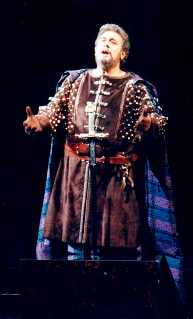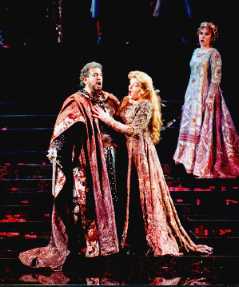|
seit/since
1999
|
|
|
|
Teatro de la Maestranza, Seville (ESP), Premičre
El Cid
(Le Cid)
|
 |
 |
Plácido Domingo as Le CidPhoto: G. Mendo Murillo, Sevilla |
The monument of El Cid at Sevilla
Photo: Birgit Popp
|
For the Teatro de la Maestranza the 'El Cid'-production highlights the whole season and might be even the greatest highlight among many others since the existing of the opera house. The Teatro de la Maestranza was inaugurated in October '91 in view of the Expo 1992 at Seville. In the first years of its existence the Teatro de la Maestranza had mainly been used for concerts, but since the mid-nineties it has developed beside Madrid and Barcelona to one of the leading opera houses in Spain. But, also today the Teatro has a wide range of activities from opera performances to symphonic concerts, ballet and concerts of different artists.
To the celebrated stars of the premičre of 'Le Cid' besides Plácido Domingo belonged Ferruccio Furlanetto, who obviously received the most applause of the first night, and Elisabete Matos. Vocally and from the acting part the performance of the Italian bass as in his honor hurt and therefor in his search for revenge the luck of his son destroying, old Don Diego was not to top. His dramatic voice and his vibrato are unbelievable gripping as well in the moments of pride and revenge as in the moments of grieve. Who had seen him last as the comic 'Mustafa Bey' in 'L'italiana in Algeri' at Vienna and now in 'Le Cid' did almost not believe that it was the same singer. Already as 'Zaccaria' in 'Nabucco' Furlanetto had reserved great ovations at Seville. In a splendid form was also the Portuguese soprano Elisabete Matos, who had been already at Plácido Domingo's side in 'Divinas Palabras' at Madrid two years ago for the reopening of the Teatro Real. In the dramatic role of Chimene she is torn between her love to Rodrigue and her revenge against her lover, who had killed her father Count de Gormas to rescue the honor of his father Don Diego beeing insulted by the count, till finally the love to the victoriously returning 'Le Cid' wins. Her aria 'Pleurez mes yeux' sung full of pain and intensity belonged to the greatest highlights of this evening. Her heights, her security, her vocal appearance were highly impressive. Also the love duet between Chimene and Rodrigue could not have been more intensive and dulcet from both sides. As in his aria 'O souverain, o juge, o pčre' Domingo's voice went directly to the heart. His register in the mid-range has not lost intensity, warmth and expression. His art to model the phrases and to change from one register to another is still an idol for most other singers. In general the role of 'El Cid' requires also a lot of physical strenght of the tenor, since he has almost always to be present comparable to only few other operas, what makes an intelligent managment of the singer's resources necessary. To the outstanding appearances of the evening belonged also Eva Santana as 'Infante' with her clear, shining soprano. But also all other roles were vocally very well casted.

The scenario of details loving sets and splendid costumes - created by Hugo de Ana with great precession and grandezza and dived in to real red - protuced a revival of the 11th century and the court of Alfonso VI. in all its overwhelming splendor. Not only the ears, but also the eyes experienced magnificent moments. Also well arranged but nevertheless overall quite dark was the lightning. A bit more light would have revealed even more the splendor of the sets and costumes. The choir of the friends of the Teatro de la Maestranza, whose members are not employed by the theater, was very well instructed by the Argentine choir director Vicente la Ferla with a lot of feeling for the 'Grand Opéra' and its typical, grandiose choir scenes. The choir performed remarkably not only what belongs to its singing, but also to the physical performance getting up and down the stairs in the heavy costumes. The musical director of the production and the conductor was the musical director of the Teatro Real at Madrid, García Navarro, who directed the symphonic orchestra of Seville. Also about the performance of the orchestra can be said mainly positive things, but the overture could have been done more accurate. Its 'solo scene' had the orchestra with the ballets in the beginning of the second act. But from the typical dances of seven provinces of Spain third were totally cut out and the rest mostly extremely shortened. Nevertheless, the choreography was well executed, what was not easy because of the stairs and the time for the ballet was adequate. A pity was that also the 'Rapsodie mauresque' had been cut out. But in any case it was a long, splended night of the kings and the Cid.

Copyright for Text & Layout © 1998 - 2012
Birgit
Popp Alle Angaben ohne Gewähr. Für die Gültigkeit und Richtigkeit der auf dieser Website veröffentlichten Namen, Angaben, Termine und Daten wird keine Haftung übernommen, ebensowenig für den Inhalt von Websites, auf die Links verweisen. No responsibility is taken for the correctness of names, dates or other information published on this website as well as for the contents of websites links are pinting to.
|